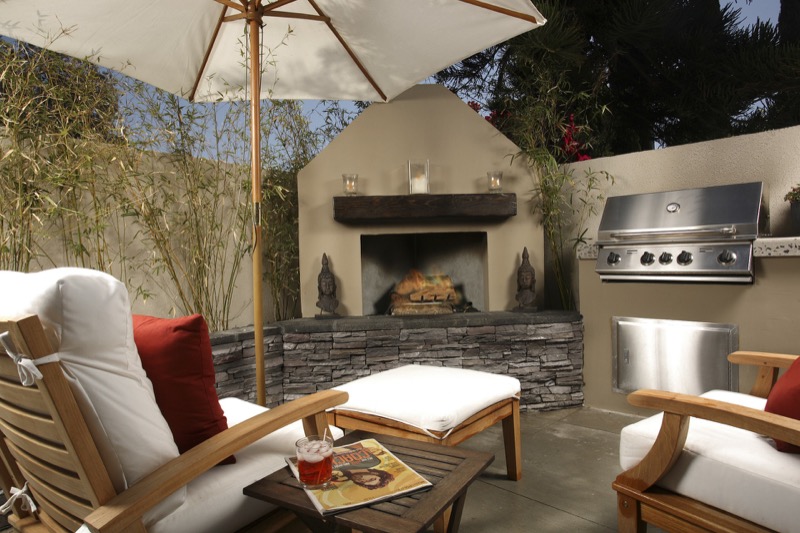Before buying an outdoor fireplace, there are several factors to take into account. Always remember that the safety of your family and property is the most important consideration.
1. Size matters
When comparing fireplaces, look at the size of the fire area before the height. If the firebox is small, wood buying and cutting is more difficult.
Requesting for specially cut wood from your supplier increases your cost.
Try to find a large firebox, don’t bother with the tall and thin fireplace. A small firebowl will cost more down the road. You don’t need a large fire just because you have a large fireplace, just use less wood to have a smaller fire.
A good fireplace burns more cleanly and more efficiently than a firepit design having no smoke stack. The fireplace draws air into the fire and blows out the neck for an efficient burn. Firepit designs tend to smoke and smolder much more than a traditional fireplace design because of poor airflow.
2. Proper maintenance
Fireplaces made in the more commercial copper, clay or sheet steel don’t have the longevity or safety of aluminum or cast iron. Sheet metal fireplaces are available at a bargain cost. They’re pretty much a disposable type of fireplace. Once metal sheet fireplaces start to rust, they have already outlived their usefulness. Check the gauge or thickness of the metal. A metal too thin might melt.
Some cast iron fireplaces have sheet metal necks. If that’s the case, check if the manufacturer has replacement parts available and cost. Frequent replacement for the neck is not what you want.
Cast iron must be maintained to prevent rust. It is a little difficult to maintain. But a well maintained cast iron fireplace will last you a long time. Also, consider the placement of your cast iron fireplace.
The cast iron fireplace tends to stain the surface it stands on.
An occasional paint job with a high temperature paint will slow down rusting. The cast iron is heavy and can stand a lot of abuse.
Copper looks great initially but after a couple of uses it tends to be green and rusty. Several companies put holes in the bottom of the firepits to drain ash and water out during rain. Firepits without holes will be filled with water when it rains.
Cast Aluminum is one of the best buys. It is easy to maintain and a long lifespan. An aluminum fireplace does not warp and only has a slightly lower melting temperature than cast iron. Cast aluminum does not rust. It is also considerably lighter than cast iron making it easier to move around.
3. Weigh it
When comparing fireplaces, check the weight. Most fireplaces are produced by weight, so they are bought by weight. Be sure that you’re comparing the same material, copper to copper or cast iron to cast iron.
4. Aluminum feature
Cast aluminum is by far a better choice for a novice outdoor enthusiast. The fireplace is easier to maintain and can be easily moved around. It may be brought to a home by the lake or stored during winter along Northern areas. Store it to prevent damage or possible theft.
5. Clay fireplace
The most disturbing problem with a clay fireplace is that it can fall apart without prior warning. When the bottom falls out, it can be quite a mess. Avoid placing your clay fireplace on a wooden deck or any surface that can easily be damaged by heat or fire. Place it on cement or tile.
If you choose to purchase a clay fireplace, take safety precautions. Use a spark arrestor and a mouthscreen for safety. The extra cost is well worth it. A clay fireplace is generally cheaper but has a shorter lifespan than either aluminum or cast iron.
6. Surround view fireplaces and raised firepits
Most surround view fireplaces are built with light materials. Surround view fireplaces are easy to tip over because of the light material used to make it. When it is tipped over, it will send ash and embers everywhere.
Safety is an issue with surround view fireplaces. Slight breezes might send embers and catch fire with flammable materials.
If you’re buying a raised firepit, be sure that it comes with a lid. Otherwise, ash will be spread all over your patio when it rains.
7. What to burn
Hardwood is by far the most popular fuel for outdoor fireplaces. Pinon wood has a pleasant pine scent when burning. It keeps the flame active and generates good heat. It also helps in keeping insects away. Other fuel sources are propane, gel inserts, manufactured firelogs and natural gas.
Pine cones and applewood can be added for more aroma.
Several fireplaces come with inserts for natural gas and propane.
Thank you for taking the time with me to learn more about what Mr. Done Right, the handyman / contractor does for you.
Sincerely,
Nathaniel Peterson
(AKA) Mr. Done Right
For more information on handyman or contractor work in the greater Austin area (or beyond), please contact your premiere handyman, Nathaniel Peterson, AKA Mr. Done Right Handyman Contractor of Austin, because Mr. Done Right ensures any repairs and/or remodels get Done Right the first time! Call us now for a free estimate! 512-659-8931
* Click here to protect your privacy and the safety of your children on the Internet.
Online Marketing Powered by www.OnlineMarketingExperts.agency





Recent Comments